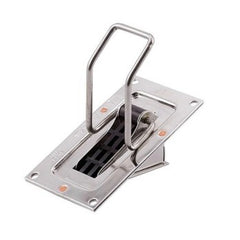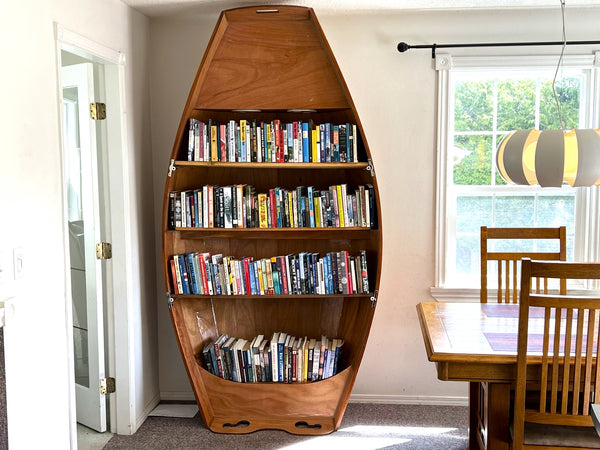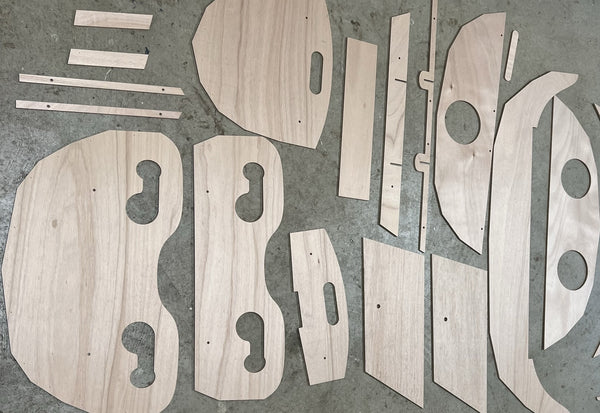Bailers, Pumps and Other Systems for Getting Water Out of a Small Boat
Some boats are shaped so that all water that comes aboard is removed with gravity. This is how a typical cruising sailboat works. The cockpit is raised above the waterline, and a simple drainage system allows water to quickly flow away. With smaller boats, however, having cockpits high enough to self-drain is usually impractical, so there is always the potential to accumulate water in the cockpit. For un-decked boats much more water can collect and quickly become dangerous.
So what is the most effective way of removing water from your small vessel? As with most things there is no one good answer. There are a variety of solutions depending on expected sea state, the type of vessel, and a great number of other factors. Below we go through the pros and cons of various water extraction solutions.
Hand Bailer and Sponge: There’s no denying that this classic

solution is effective, economical and reliable. Whether you’re in a canoe, a rowboat or any other type of small craft this is a good solution for quickly removing water. It can be faster than an electric pump, and the sponge can be used to remove every last bit of water that can’t be scooped. Make sure to use a bailer suitably sized for your cockpit. A big bucket may not be effective in a small cluttered space. A plastic juice pitcher can work well, or robust bailers can be purchased at most marine stores. Be sure to have it secured to your vessel so it doesn’t wash away.
The downside to a hand bailer is it requires one person to take their hands away from other tasks such as rowing or steering. In modest conditions this may not be a big deal, but in monster boat-rolling waves, it may be necessary to have all hands (especially for singlehanders) keeping the boat under control.
Regardless of whether another system is used, a bailer is always good to have

as a backup system.
Hand Pump: For most situations in a small boat, I don’t recommend a portablehand pump. Usually, a bailer is faster and is most definitely more reliable and less expensive. The only time a hand pump is superior is when water needs to be drawn from a hard to access space where the hand bailer is too large to fit in. It can be useful for extracting water from leaky lockers or other compartments.

Suction Self-Bailing Systems: The Andersen Self Bailer is the best example of a suction self bailing system. It is mounted in the lowest part of the hull, and the device can be opened or closed depending on whether it is needed. When opened, it protrudes through the bottom of the hull. The low pressure (read turbulence) created from movement through the water on the back side of the device sucks water out.
The advantage of this system is it’s simple, reliable and hands free, so significantly increases safety when all hands are required for boat control.
I used the Andersen Self Bailer on the sailing RowCruiser, and less than thrilled with the results. It did work well and effectively at high speeds (about 4.5+ knots) – in the kinds of conditions when waves are crashing over the boat and you need it to work. However, at lower speeds, when closed it would always leak, requiring continuous mopping of the bilge with a sponge. Basically, I ended up bailing the boat twice as much because of my Andersen Self Bailer. I wasn’t a big fan of having all my cockpit gear soggy when calm water cruising. It also didn't work well when rowing instead of sailing.
A suction bailer is useful in a fast sailing dinghy-style boat where continuous splashing and water are a part of the fun, but not so ideal in broader use recreational craft where having some time with a completely dry cockpit is appreciated. Additionally, an Andersen Bailer does not work well in human powered craft where the lower speeds aren’t sufficient for the system to work.
Electric Bilge Pump I only recently tested out an electric pump system and was 
thrilled with the results. Often, electric bilge pumps are associated with larger boats due to their complexity and associated power systems, however, I found they work surprisingly well in small boats as well.
I installed the electric bilge pump in one of our Expedition boats as I prepared for the first leg of the R2AK – a treacherous crossing of the Juan de Fuca Strait. Normally, with the Expedition, I’ve simply used a hand bailer in rougher conditions when waves occasionally washed into the cockpit.
With gale-force winds forecast, I decided to quickly re-think my water extraction system. If the waves were huge, it might not be possible to take my hands off the oars.
After a quick search on Amazon.ca, I found a small lithium ion battery pack and a small 600 GPH (gallons per hour) bilge pump. The pump had an internal float switch, which is ideal in a small cluttered environment. The lithium ion battery pack outputted 12 volts (which is not common) required for the bilge pump.
The bilge pump consumes about 30 watts and the lithium ion battery pack has a capacity of 72 Wh, meaning the bilge pump could run continuously for over two hours on a full charge. This seemed pretty good for a battery pack that weighed less than a lb.
Because I was in a rush to install it, I merely secured the bilge pump to the bottom of the cockpit with a dollop of epoxy, and duct taped the non-waterproof battery inside the aft compartment. I drilled a small hole through the bulkhead to run the wires and sealed it with a dollop of caulk. There are two positive wires that come from the pump – one that bypasses the float switch, allowing you to manually turn it on. The best way to make use of this is to install a switch of sorts. In my haste, I just had two bare wires that could be connected for a manual emergency override. Fortunately, the float switch worked perfectly, so I didn’t need to use the override.
The long and short is the system worked very well. I ended up voyaging through breaking waves of up to 12 feet, and the cockpit was fully flooded countless times. I needed to keep my hands on the oars at all times to keep from broaching, and this pump system allowed me to do that. You can read about this adventure here.
Because of the flat bottom of the cockpit, the pump was never able to suck out the last quart or so of water, but this was not a safety concern. For those looking to maximize the effectiveness of a pump system, a well/sump can be created in the cockpit. While this would require cutting a hole in the boat, and having some sort of streamlined pod protruding out from the hull, it would allow for a very dry interior, and create much less drag than an Andersen bailer.
Overall, I was very impressed with the electric pump system, and plan on continuing to use this system for big-water rowing. I feel an electric pump with a backup bailer offers the greatest level of safety and effectiveness.
Capsize Water Extraction: This is perhaps the most exhilarating (or scariest) way of removing water from your boat. This solution only works for a few designs where the cockpit is shaped to shed water in the righting process. When the boat flips over, the water drains out, and when the boat is righted no water re-enters the cockpit. This method of “quick bailing” is only suitable in warm climates or when rowing with drysuits/wetsuits. Alternatively, it’s very useful for accidental capsizes, which allows you to right the boat and be underway again in seconds. It’s extraordinarily reassuring in the panicky conditions that accompany a capsize to have a dry boat, rather than a vessel full of water. Both our Expedition boat and RowCruiser are designed to shed water in a capsize, and you can see how this concept works in this video.
6 Responses
James Gibling
I remember seeing your pump when I came in on R2AK 2022. After reading your blog, I decided to pick up the electric bilge pump. Spent a good time under that 4.5 knot speed for the Anderson self bailer to work properly so my bailing bucket got to much use haha! Thanks for the detailed blog! Always appreciated!
mike
Hi Colin, I’ve been thinking about this having read your R2AK adventure. Have you or anyone else tried the foot pressure bilge pumps that kayakers use? Something like this: http://www.kirtonkayaks.co.uk/home/customise/137-footpump – not great for full-on storm conditions but probably work for the occasional wave in more normal conditions?
Colin Angus
That’s a good question, James. Normally, the standard gasket and well-cinched straps are enough for regular conditions, and the worst that’s going to happen is you may get a few cups of water in the compartments. However, when I’m doing particularly nasty stuff, out in big waves and more than five miles from shore, I put a wrap of duct tape around the perimeter of the hatches. That’s what I did for the R2AK, and there wasn’t a drop of water in the boat despite the submarining adventures.
Colin Angus
Here’s some useful information posted by Michael B on our FB page: Good article!! Totally agree that for the most part conditions that put water in the expedition cockpit are conditions where you’re unlikely to be able to take hands off the oars.
Minor edit – gph = gallons per hour, not gallons per minute. That’d be a serious pump!! 😁👍
Also fwiw – RC plane/car lipo batteries are an option. They’re nominally 3.7v/cell, 4.2v fully charged. So 3 cell (called 3s in the RC world) are 12.6v fully charged, and 4s are 16.8v fully charged. I’ve used both as 12v vehicle battery replacements. They’re very light weight for the power available. You do need to use a charger specifically designed for them, and you do need to read up on lipo battery safety as they are capable of catching on fire if mistreated.
You can also get motorcycle batteries in lipo these days that have some built in protection circuitry, and many can be charged with “regular” chargers.
NW company Dakota Lithium makes very high quality lipo batteries, and does also have some self-contained battery box options. Ralph Allen has some experience with Dakota products I believe in his beautiful rowboat Starlight.
I currently have a 50w solar panel charging a lead-acid motorcycle battery I use to keep the GPS and vhf radio charged which will eventually be changed to lipo. Adding a bilge pump should be a breeze! How did you run the discharge pipe from the pump?
Colin Angus
Here’s some useful information posted by Michael B on our FB page: Good article!! Totally agree that for the most part conditions that put water in the expedition cockpit are conditions where you’re unlikely to be able to take hands off the oars.
Minor edit – gph = gallons per hour, not gallons per minute. That’d be a serious pump!! 😁👍
Also fwiw – RC plane/car lipo batteries are an option. They’re nominally 3.7v/cell, 4.2v fully charged. So 3 cell (called 3s in the RC world) are 12.6v fully charged, and 4s are 16.8v fully charged. I’ve used both as 12v vehicle battery replacements. They’re very light weight for the power available. You do need to use a charger specifically designed for them, and you do need to read up on lipo battery safety as they are capable of catching on fire if mistreated.
You can also get motorcycle batteries in lipo these days that have some built in protection circuitry, and many can be charged with “regular” chargers.
NW company Dakota Lithium makes very high quality lipo batteries, and does also have some self-contained battery box options. Ralph Allen has some experience with Dakota products I believe in his beautiful rowboat Starlight.
I currently have a 50w solar panel charging a lead-acid motorcycle battery I use to keep the GPS and vhf radio charged which will eventually be changed to lipo. Adding a bilge pump should be a breeze! How did you run the discharge pipe from the pump?
James
Great post, thanks Colin. How did you modify the hatches of the Expedition to be watertight and secure in big seas? I’m currently thinking of ways to secure my Expedition hatches to cope with short steep chop bashing at them.
Leave a comment
Comments will be approved before showing up.
Also in News

Human Powered Achievements through the Northwest Passage
At Angus Rowboats, our passion for adventure naturally draws us to the mystique of the Northwest Passage – one of the world's most captivating and perilous waterways. Historically, this elusive passage promised a shorter shipping route, spurring early navigators to fervently chart and struggle through its icy intricacies.
The summer of 2023 saw three audacious teams, including one using our very own RowCruiser boats, aiming to be the first to traverse NW Passage solely by human power within a single season. As the season concludes, we've chronicled these attempts, and catalogued past human-powered endeavors to navigate the Northwest Passage.

Creating a Bookcase from a Boat


Colin Angus
Author